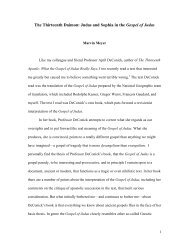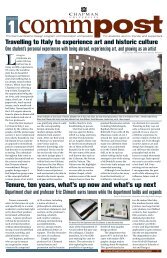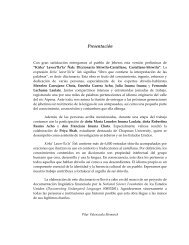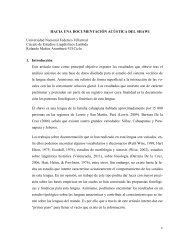“Surplus Humanity” and the Margins of Legality - Chapman University
“Surplus Humanity” and the Margins of Legality - Chapman University
“Surplus Humanity” and the Margins of Legality - Chapman University
Create successful ePaper yourself
Turn your PDF publications into a flip-book with our unique Google optimized e-Paper software.
Do Not Delete 12/12/2010 7:34 PM<br />
26 <strong>Chapman</strong> Law Review [Vol. 14:1<br />
early examples <strong>of</strong> this model <strong>of</strong> urban growth <strong>and</strong> <strong>the</strong> emergence<br />
<strong>of</strong> slums.<br />
Planned urbanization proves particularly attractive to<br />
finance capital because this unavoidably state-sponsored <strong>and</strong><br />
debt-financed activity gives speculative capital security <strong>of</strong><br />
accumulation without getting directly involved with <strong>the</strong><br />
politically volatile terrain <strong>of</strong> industrial production. The first<br />
prototype <strong>of</strong> planned urban development under capitalism was<br />
furnished by <strong>the</strong> rebuilding <strong>of</strong> Paris in <strong>the</strong> 1850s <strong>and</strong> 1860s<br />
under Georges-Eugene Haussmann. 165 As a consequence <strong>of</strong><br />
state-sponsored urban reconstruction, Paris emerged as a center<br />
<strong>of</strong> commerce <strong>and</strong> bourgeois life, <strong>and</strong> its emerging slums were<br />
removed from <strong>the</strong> heart <strong>of</strong> <strong>the</strong> city to its outer rim. 166 While<br />
Haussmann‘s designs ―transform[ed] <strong>the</strong> capital city into <strong>the</strong> city<br />
<strong>of</strong> capital,‖ 167 <strong>the</strong>y also demonstrated that ―<strong>the</strong> root cause <strong>of</strong><br />
urban slumming seems to lie not in urban poverty but in urban<br />
wealth.‖ 168<br />
The Haussmann model was replicated in <strong>the</strong> United States<br />
after World War II; first in New York under Robert Moses, <strong>and</strong><br />
<strong>the</strong>n in most metropolitan areas. 169 While predominantly white<br />
middle classes, ensconced in debt-financed suburbia, turned to<br />
<strong>the</strong> pursuit <strong>of</strong> individual accumulation, protection <strong>of</strong> property,<br />
<strong>and</strong> so-called family values, <strong>the</strong> darker under-classes <strong>and</strong> <strong>the</strong><br />
marginalized had to contend with removals, blighted inner-city<br />
ghettos, <strong>and</strong> inhuman public housing projects. This phase <strong>of</strong><br />
finance capital‘s deployment in urban reordering ended with <strong>the</strong><br />
property-market crash <strong>of</strong> 1973, <strong>and</strong> bankruptcy <strong>of</strong> New York City<br />
in 1975, with global repercussions. 170 The recipe <strong>of</strong> neoliberalism<br />
163 GARETH STEDMAN JONES, OUTCAST LONDON: A STUDY IN THE RELATIONSHIP<br />
BETWEEN CLASSES IN VICTORIAN SOCIETY 209–10 (1971).<br />
164 FRANK M. SNOWDEN, NAPLES IN THE TIME OF CHOLERA, 1884–1911 38–40 (1995).<br />
165 For a detailed account, see MICHEL CARMONA, HAUSSMANN: HIS LIFE AND TIMES,<br />
AND THE MAKING OF MODERN PARIS 149, 151–52, 155–56 (2002).<br />
166 See id. at 9, 432–39; DAVID HARVEY, PARIS, CAPITAL OF MODERNITY 95–99 (2003).<br />
167 Derek Gregory, Introduction: Troubling Geographies, in DAVID HARVEY: A<br />
CRITICAL READER, supra note 101, at 13.<br />
168 VERMA, supra note 55, at xix.<br />
169 See Kenneth T. Jackson, Robert Moses <strong>and</strong> <strong>the</strong> Rise <strong>of</strong> New York: The Power<br />
Broker in Perspective, in ROBERT MOSES AND THE MODERN CITY: THE TRANSFORMATION<br />
OF NEW YORK 67, 70–71 (Hilary Ballon & Kenneth T. Jackson eds., 2007). In <strong>the</strong> process,<br />
<strong>the</strong> scale <strong>and</strong> scope <strong>of</strong> urbanization was transformed by re-engineering not just existing<br />
cities but whole metropolitan regions through suburbanization, highway systems, <strong>and</strong><br />
infrastructural transformations. Finance capital found a new outlet in public <strong>and</strong> private<br />
debt, while urban geography <strong>and</strong> demography reconfigured class <strong>and</strong> race divides.<br />
170 See ROBERT A. CARO, THE POWER BROKER: ROBERT MOSES AND THE FALL OF NEW<br />
YORK 615–16, 618–19, 795, 899–900, 902–04 (1974); Roger E. Alcaly & Helen Bodian,<br />
New York‘s Fiscal Crisis & <strong>the</strong> Economy, in THE FISCAL CRISIS OF AMERICAN CITIES 30,<br />
30–33 (Roger E. Alcaly & David Mermelstein eds., 1977).

















